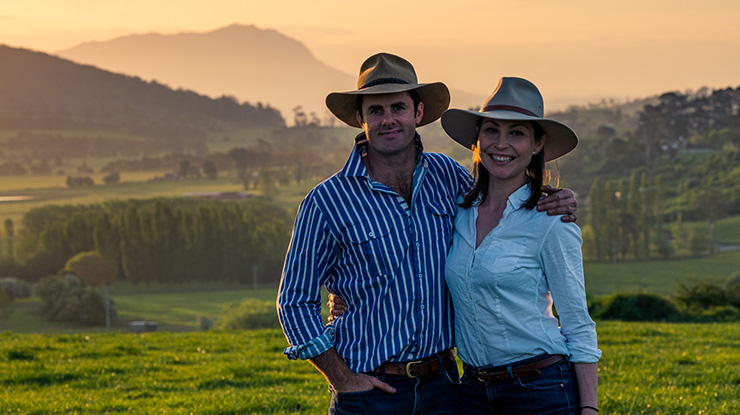 Sam and Stephanie Trethewey have used MLA CoMarketing funding to help build their Tas Ag Co beef brand. Image: Andrew Wilson Photography
Sam and Stephanie Trethewey have used MLA CoMarketing funding to help build their Tas Ag Co beef brand. Image: Andrew Wilson Photography
Tasmanian producers Sam and Stephanie Trethewey are pedalling hard to get their beef brand to market.
While Sam reckons the challenge comes from 'building the bike as they pedal', it could also be said they are actually custom‑designing the bike rather than sticking to a proven formula.
The Tretheweys founded the Tasmanian Agricultural Company (Tas Ag Co) on their passion for restoring native ecosystems and rebuilding soil health through data‑backed management practices and carbon farming. Along the way, they're creating a nutritious and sustainable food product for conscious consumers.
While it's early days – the data is yet to come in and the beef is yet to go to market – Sam and Stephanie's passion and commitment is solid.
They're taking an innovative approach in their aim to produce great, grassfed Wagyu beef from multi‑species pastures, and don't own a single breeding cow.
This minimised the initial outlay required for the agricultural start‑up. Here's how it works:
- Sam and Stephanie supply the Wagyu genetics – either as semen for AI or as live bulls – to nine Tasmanian dairy farms.
- They then buy back all the first‑cross calves from the dairies – providing a market for bobby calves and producing calves for Tas Ag Co without the need to own breeding stock.
At this stage, the Tretheweys are running 1,600 head and will soon expand by another 700 head.
Brand plans
The Tretheweys are currently preparing to launch their product and have relied on MLA's CoMarketing Program to get off the ground.
"The capital up front is really tricky when you're building a new brand," Stephanie said.
"MLA's CoMarketing Program has been critical for us. We've put the funding into things like photography, building our website and our brand design.
"The program has helped us with a lot of those big‑ticket marketing items. We couldn't have done it without it."
Stephanie and Sam are buoyed by early interest from chefs, butchers and retailers.
As a young couple with a growing family, they're under pressure but said it's exciting rather than scary.
"It's a two‑man show and it's hard work, but there's no turning back now," Stephanie said.
"I think a lot of farming families can relate to that. We're taking a risk but it's exciting. We're just going to have a crack.
"For us, it's about what consumers will increasingly start to demand, and a growing number are environmentally conscious."
Carbon farming
In 2019, Tas Ag Co became the first Tasmanian farm to register a soil carbon project through Australia's $2.5 billion Emissions Reduction Fund. Their aim is for their enterprise to sequester more carbon than it emits.
They're using a soil carbon measuring protocol eligible under the United Nations Paris Agreement.
Another important tool is MLA's greenhouse gas emissions calculator, provided through the University of Melbourne, which enables the Tretheweys to examine their on‑farm emissions sources and carbon storage options.
"Our approach and philosophy is that we need to reverse the damage done to our soils," Sam said.
They're taking a three‑pronged approach involving time‑controlled grazing, multiple‑species pastures, and avoiding the use of synthetic pesticides, fungicides, herbicides or granular fertilisers.
While Sam acknowledges some of these practices aren't for everyone, he believes the direction they're going in is where the red meat industry needs to head.
In time, the Tretheweys aim to have data that proves their approach is at least as profitable as conventional methods, while having better environmental outcomes.
"I'll be one of the trial dummies. I'll see how it works. Maybe in time people will look at what we and others are doing, see the numbers and be inspired to do it too," Sam said.
Strategies
The Tretheweys describe their approach to planting a diverse mix of feed options rather than a single species as mimicking mother nature.
"Our species mixes include at least one of each of the five main groups – brassicas, legumes, cereals, grasses and chenopods. Sometimes we use two or three species of each group. We've used up to 26 species in a mix."
They use a custom‑designed pasture renovator to over‑sow paddocks, which uses a small amount of tillage to remove existing grass species so they can sow about 25% of the paddock to multi‑species.
"Once that's established, the cattle prefer the multi‑species; they enjoy the diversity," Sam said.
Stocking density is also an important part of grazing management, and the Tretheweys run 28 DSE/ha.
"I've seen the producers who focus on soil health have the most resilient land. They're the last to go into a drought and the first to come out of it," Sam said.
Lessons learned
|






